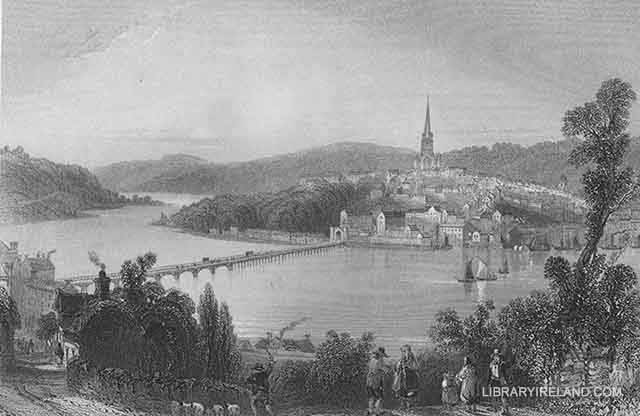Dunluce to Coleraine and Limavady
FROM Dunluce we travelled southward to Coleraine, a remarkably neat and pretty town, and thence by Limavady to Londonderry, a part of Ireland abounding in rural beauty, and wearing more the look of England than any other that we had seen. From the hill by which we descended to Derry, the view was like one of an illuminated city, several large factories, with a bright light streaming from every window, standing opposite to us, and the hill within the walls showing apparently a light in every house. We entered the city over a bridge, built by Lemuel Cox, of Boston, United States, another of whose bridges we had crossed at Wexford. This over the Foyle is a wooden structure, one thousand and sixty-two feet in length, and considered here a great curiosity.
Londonderry occupies the sides and summit of a steep promontory, almost peninsulated by a noble sweep of the smooth, deep Foyle, whose waters glide majestically on towards a broad estuary, where they are mingled with the ocean. The old town is included within the walls, and entered by the ancient gates, still entire; while the gradual increase of population and commercial prosperity have occasioned an extension of the city avenues to a distance beyond them. The steepness of the ascent from the water's edge to the summit of the hill, particularly up the Ship-Quay Street, is so great, as to be nearly impracticable by carriages, or, at all events, to be highly dangerous; and the citizens tell a tale of the respectable inhabitants of this old-fashioned street, that when they visited each other in the winter season their passage was accomplished by self-moving sledges; a form turned upside down having once conveyed a group returning from an evening party, in safety and with expedition, to the foot of the hill.
The Diamond, for so the central square or market-place is generally called, is the point from which the other streets emanate; and here the town-hall and reading-rooms are erected. Some of the buildings appropriated to the public business are handsome; all are spacious and convenient. The court-house, a fine elevation in the Grecian style is after a design by Bowden; the principal front displays much grandeur and beauty, but the lateral entrances and fronts are in a very inferior manner. The old palace, the grammar-school, and the lunatic asylum, possess no architectural elegance, but are built after liberal and useful designs. On the apex of the hill of Derry stands the church, which is both parochial and capitular: it is a venerable structure, in the pointed style, with finials and graduated battlements, but, incongruously enough as a cathedral, finished with a tower and spire. Within are preserved standards and trophies, and other relics of the bravery of the ancestors of the citizens, and of the memorable defence made by them.

